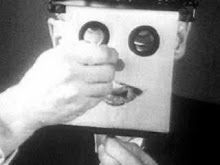Last spring I visited the new casino at Niagara Falls. What fascinated me was how the streets all curved in ways that, about every ten paces, provided new visual perspectives of the relatively small area. It seems bigger than it is, thus far, and even the physical relationship to the falls themselves was something like a constantly adjusted reality.
A more recent New Year's Eve visit confirmed this surreality, with old motels demolished and old hotels being remodelled, amid a flourish of different honky-tonk attractions on Clifton Hill. Touring the season's light displays, and recalling their connection to the lights beamed onto the falls, reminded me that Niagara has long had a connection to Ontario's fantasy of cheap, abundant electrical power and the industrial future it would create, a fantasy we've pretty much experienced.
In December we were in Las Vegas, our first visit. It is virtual reality incarnate. In one evening you can visit New York without the rudeness, Paris without learning French, or Venetian canals without the sewage. The place reads the pulse of the global culture's biggest fantasies, the newest of which is architectural, with condos and halls designed by some of the world's biggest names. Libeskind and Gehry fantasies have altered physical realities all over the world.
As older novices we tended to think of Vegas gambling in terms of winning and losing. There's certainly that, but there's also gambling as a budgeted expense. For as little as a few cents a go, solid, down to earth, middle-class citizens can live as if they have money to lose. This is the ultimate fantasy of the consumer society, to have so much money losing it doesn't matter. If you
do win, if you have anything left in the budget, spend it on everything from fridge magnets to designer jewellery, furniture and art.
The expensive stuff may be industrial-era mass produced as the ball caps and T-shirts, and one wonders if it sells. But the shops are there, and in quantity. Most surreal were the number of construction cranes in the sky, and the crowds in the casinos as the industrial economy outside Vegas scurried for defibrillators and adrenalin shots.
Through gaming, Las Vegas sustained an economy based upon selling people their dreams. Can this continue during the information age?
In Ontario, race-track casinos revived the declining horse-breeding industry. Could casinos do the same for real art if galleries were nearby? Art is about envisioning alternative realities, after all. Niagara-On-The-Lake successfully sells a Disneyfied historical fantasy, with theatre as a central attraction. Torontonians making money from the industrial economy have invested in Tuscan fantasies by buying small Niagara vineyards and wineries. Pottery studios and galleries line the lanes as well, and the region has long had a strong literary community. It's all fantasy, of course, but what's real about "the freedom of the open road" or denying global warming or the notion that billions of government dollars can revive a beyond-mature industrial economic base?
Visiting Niagara I've had the sense of a subtle economic shift from Toronto to Niagara, from an industry/resource base to an expressive possibilities context. It's not an either/or choice of course, but if it were I'd rather spend the future crawling through a wormhole to alternative realities than be in a traffic jam on the QEW running low on gas. I don't think I'm alone.

